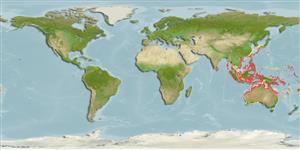Preferred temperature (Ref.
123201): 24.9 - 29, mean 28.1 °C (based on 392 cells).
Phylogenetic diversity index (Ref.
82804): PD
50 = 0.5005 [Uniqueness, from 0.5 = low to 2.0 = high].
Bayesian length-weight: a=0.00708 (0.00333 - 0.01504), b=3.09 (2.92 - 3.26), in cm total length, based on LWR estimates for this (Sub)family-body shape (Ref.
93245).
Niveau trophique (Ref.
69278): 3.2 ±0.3 se; based on size and trophs of closest relatives
Résilience (Ref.
120179): Haut, temps minimum de doublement de population inférieur à 15 mois (Preliminary K or Fecundity.).
Fishing Vulnerability (Ref.
59153): Low vulnerability (10 of 100).
Nutrients (Ref.
124155): Calcium = 826 [402, 2,397] mg/100g; Iron = 2.21 [1.13, 4.78] mg/100g; Protein = 16.9 [15.0, 18.6] %; Omega3 = 0.173 [0.062, 0.428] g/100g; Selenium = 41.7 [16.3, 109.6] μg/100g; VitaminA = 38.1 [9.8, 152.2] μg/100g; Zinc = 3.24 [2.02, 5.21] mg/100g (wet weight);
